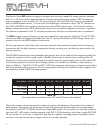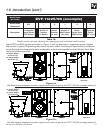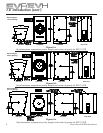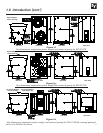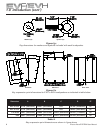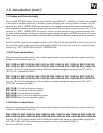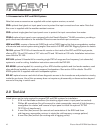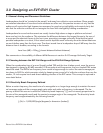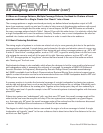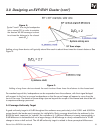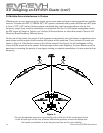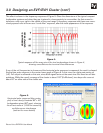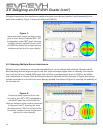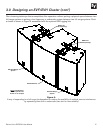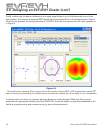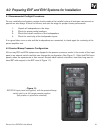
Electro-Voice EVF/EVH User Manual
3.0 Designing an EVF/EVH Cluster (cont’)
3.3 More on Coverage Patterns, Multiple Coverage Patterns, the Need for Clusters of Loud-
speakers and How Far a Single Cluster Can “Reach” into a Venue
The coverage patterns or angles mentioned previously are defined where loudspeaker output is 6 dB
down from maximum, usually on-axis level. In order to help cover only the absorptive audience with sound,
given different trim heights and the wide variety of venue shapes, the EVF and EVH series are offered in
the many coverage patterns listed in Table 1 (above). Even with this wide choice, it is relatively unlikely that
a single loudspeaker will cover the audience uniformly. Therefore, two or more loudspeakers are often as-
sembled into clusters and aimed in different directions in order to reach the entire audience.
3.31 Basic Clustering Guidelines
The aiming angles of systems in a cluster are related not only to room geometry but also to the particular
coverage patterns selected. A rough design can be based on the plan and elevation views of a room, rep-
resenting the loudspeakers by the angles of their horizontal and vertical coverage patterns, e.g., 60° x 40°.
A wide or “short throw” coverage pattern, such as 120° x 60°, is good for aiming down into the front rows
of a rectangular venue to reach all of the seats left to right. Narrower patterns, such as 60° x 40° and
40° x 30°, are appropriate as “long throw” devices that send sound to the rear of the audience without
also “blasting out” the front rows.
Sophisticated software is also available, which allows the designer to build a room model and place and
aim loudspeakers within it, assessing the uniformity of coverage. An example is EASE 4.2 (Enhanced
Acoustic Simulator for Engineers), developed by Acoustic Design Ahnert (www.ada-acousticdesign.
de). EASE is available from the Bosch Communications Systems/Electro-Voice technical support group;
specific contact information can be found at www.electrovoice.com. EASE loudspeaker data for EVF and
EVH systems may be downloaded at www.electrovoice.com.
A common practice is to widen the horizontal coverage of a single loudspeaker by placing two systems
side by side and aiming them in such a way that their horizontal patterns do not overlap. Individually, each
system will be 6 dB down at the overlap point. Together at the overlap point, they will sum coherently to
the 0-dB on-axis level. A specific example is two 60° horizontal systems clustered together with their axes
placed 60° apart.
If these two systems are “underlapped,” with, say, their axes 75° apart, the overall coverage angle will be
wider but the level near the array axis will drop. If the two systems are overlapped to any great degree,
e.g., their axes only 45° apart, the overall coverage angle will be reduced and the interference discussed
in section 3.5 Multiple-Source Interference in Clusters will be worsened.
The degree to which long-throw devices can extend the region of uniform coverage is limited. A single
loudspeaker will typically “reach” to the rear a distance that is about twice that of the distance to the clos-
est front row. See Figure 2.
12



